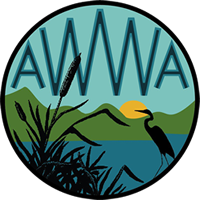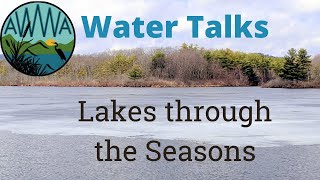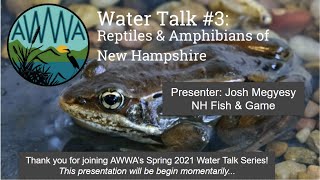Water Talk Archives
Spring 2022
Aquatic Plant Communities of the Acton-Wakefield Watershed Area
Amy Smagula – Limnologist/Exotic Species Program Coordinator, NHDES
Abstract:
Explore the vast array of common aquatic plants native to the lakes and ponds within the watersheds of Acton and Wakefield. We will discuss aquatic plant community structure, plant identification, ecology, and the functional values of these aquatic plants. The presentation will also touch on non-native invasive aquatic plants already in the area, as well as those that could be a future threat. We will also discuss control options for aquatic plants, including permit requirements related to these control actions.
Bio:
Amy Smagula is native to New Hampshire, and earned both her undergraduate and graduate degrees from the Natural Resources Program at the University of New Hampshire in Durham, focusing on topics related to water resources management and environmental science. She is a limnologist (a.k.a. freshwater biologist) with the New Hampshire Department of Environmental Services, where she has 25 years of experience surveying and managing the lakes and ponds in New Hampshire.
Lakes through the Seasons
Andrea LaMoreaux – President, NH LAKES
Abstract:
Find out how our lakes are waking up from a long winter’s nap and how they change as the seasons change. And, learn about some basic things you can do each season to keep the lake(s) that you love clean and healthy!
Bio:
Andrea joined NH LAKES in February 2007 and brings a comprehensive understanding of how to effectively work with volunteers, the ecology and health of the state’s lakes, and protecting and improving lake health. She coordinated the New Hampshire Department of Environmental Services Volunteer Lake Assessment Program for six years before joining NH LAKES. Prior to that, she worked with the BSC Group, Inc., an ecological services and engineering consulting firm headquartered in Massachusetts.
Andrea holds a Bachelor of Science degree in Environmental Science and Policy from the University of North Carolina at Chapel Hill and a Master of Environmental Management degree in Water Resources from Duke University. She has taken several continuing education classes in environmental education and nonprofit management. She is a 2016 graduate of the Leadership New Hampshire Program and currently serves on the Newfound Lake Region Association Board of Trustees. In her free time, she enjoys the outdoors kayaking, swimming, camping, and hiking with her husband (who comes from the Finger Lakes Region of New York) and their daughter.
Cyanobacteria: Biology, Ecology, and New Sampling Methods
Jim Haney – Professor Emeritus, Center for Freshwater Biology and Ecotoxicology in the University of New Hampshire Department of Biological Sciences
Abstract:
One of the most widespread problems in lakes is the increase in the toxin-producing cyanobacteria. Although the abundance of cyanobacteria is generally associated with increases in nutrients such as phosphorus and nitrogen, we are now learning that the risks associated with cyanobacteria can be related to lake-specific features and to toxic picocyanobacteria not seen in surface blooms. These smallest of the cyanobacteria can be transmitted in the air to humans and wildlife. The Ecotoxicology Laboratory at the University of New Hampshire has incorporated our current understanding of lake cyanobacteria into a 3-step citizen-based cyanobacteria monitoring program that addresses many practical concerns such as:
- What are cyanobacteria and are they in my lake?
2. Are all cyanobacteria toxic and what health risks do these toxins pose?
3. When is it safe to recreate in the lake or to allow pets to drink the water?
4. Can blooms be predicted before they occur?
5. Is it possible to citizens to estimate whether a bloom is like to be toxic?
Bio:
Jim Haney is a Professor Emeritus in the Department of Biological Sciences at the University of New Hampshire. He is Director of the UNH Center for Freshwater Biology and co-founder of the New Hampshire Lakes Lay Monitoring Program. Dr. Haney’s professional fields include Lake Ecology, Stream Ecology and Ecotoxicology. His current research focus is on the transfer of cyanobacteria toxins within the lake food webs and their impact on humans and wildlife. Other research projects include 1) toxic aerosols as risk factors from lakes with toxigenic cyanobacteria 2) use of cyanobacteria pigments as a citizen monitoring method to predict cyanobacteria blooms and lake toxicity. He and his students have conducted collaborative research with Dartmouth-Hitchcock ALS Clinic to evaluate toxic aerosols as possible links between cyanotoxins and neurological disorders such as amyotrophic lateral sclerosis (ALS). He is also a member of the USP EPA Region 1 Cyanobacteria Monitoring Collaborative (cyanos.org).
Effects of Climate Change on New Hampshire’s Birds
Dr. Pamela Hunt – Senior Biologist for Avian Conservation, NH Audubon
Abstract:
We are already seeing some of the effects of climate change in New Hampshire, with a trend toward warmer winters, more extreme weather, and drier summers. How will our birds – both breeding and migrant – be affected by these changes as they manifest over the next several decades? In most cases we don’t know the answers, but there is often enough information to allow some informed speculation. In this talk, we explore subjects as diverse as range shifts, declining food supplies, and changes in migration patterns as they apply to the birds of New Hampshire. What will birders in the 22nd Century encounter in the Granite States forests, fields, and wetlands? Learn a little about the possibilities.
Bio:
Pam Hunt has been interested in birds since the tender age of 12, when an uncle took her to Brigantine National Wildlife Refuge in NJ. She went on to earn a B.S. in biology from Cornell University, M.A. in zoology from the University of Montana, and a Ph.D. from Dartmouth College in 1995. Pam came to NH Audubon in 2000 after five years as adjunct faculty at Colby-Sawyer College in New London. In her current position as Avian Conservation Biologist, she works closely with NH Fish and Game to coordinate and prioritize bird research and monitoring in the state, and also authored NH’s “State of the Birds” report. Specific areas of interest include habitat use by early successional birds (particularly whip-poor-wills), conservation of aerial insectivores (e.g., swifts and swallows), and the effects of events outside the breeding season on long-distance migrants. Pam also coordinated the “NH Dragonfly Survey,” a five-year project that mapped distributions of these insects throughout the state, and remains active in the dragonfly field.
Spring 2021
Cyanobacteria and the Lakes
Amanda McQuaid – Harmful Algal and Cyanobacterial Bloom Program, NHDES
Abstract:
Cyanobacteria blooms are a growing public health concern as elevated cell concentrations can present toxic conditions. NHDES issues recreational advisories when bloom conditions are confirmed. “Cyanobacteria Advisories” are issued when samples are collected and identified, with cell concentrations exceeding the state threshold of 70,000 cells/ml. “Cyanobacteria Alerts” are also shared when photos and reports have been submitted, but a sample has not yet been collected. Alerts and advisories help notify the community, advising to be on the lookout for cyanobacteria accumulations along shorelines and throughout the lake. The highest number of advisories have been issued in recent years, with 34 in 2018, 35 in 2019, and 23 advisories (plus 35 alerts) in 2020. Potentially toxic taxa have included Anabaena (Dolichospermum), Microcystis, and Oscillatoria (Planktothrix). However, there is a wide range of types of cyanobacteria identified in NH lakes. In this talk, we will discuss the importance of monitoring cyanobacteria and their toxins.
Bio:
Amanda studied at the University of New Hampshire, earning her B.S. in Marine and Freshwater Biology (2006), M.S. in Zoology (2009) and Ph.D. in Biological Sciences (2019). Her research interests include ecology, cyanobacteria, toxicology, water quality, food webs and public health. She is currently the program coordinator for the newly developed Harmful Algal and Cyanobacterial Bloom Program and oversees the Beach Inspection Program at the New Hampshire Department of Environmental Services. These programs focus on monitoring New Hampshire waterbodies for potential pathogens and toxic cyanobacteria to protect public health.
Common Loon Conservation in New Hampshire
Caroline Hughes – Staff Biologist, Loon Preservation Committee
Abstract :
For many, the haunting call of the loon is a quintessential part of the New Hampshire lake experience. Often seen as a symbol of the northern wilderness, loons are a beloved fixture on our lakes, and many lake-goers enjoy watching them as they raise their young. However, the breeding season can be a vulnerable time for loons—they face many threats, both natural and human-caused, while on our lakes. This presentation will focus on the biology, life history, and challenges of breeding loons as well as the work that LPC has been performing since 1975 to help recover New Hampshire’s threatened loon population.
Bio:
Caroline Hughes has worked as a biologist at the Loon Preservation Committee since 2016. In that time, she has thoroughly enjoyed getting acquainted with New Hampshire’s lakes and the loons and loon volunteers that call them home.
Reptiles and Amphibians of NH: Ecology, Threats, and Conservation
Josh Megyesy – Wildlife Biologist, NH Fish & Game Department
Bio:
Josh Megyesy is a wildlife biologist with the NH Fish & Game Department’s Nongame and Endangered Wildlife Program. He is the Program’s turtle specialist with extensive experience monitoring and managing populations of Blanding’s, spotted, wood, and eastern box turtle populations. Josh helps manage the Reptile and Amphibian Reporting Program (RAARP), monitors other reptile and amphibian populations, and works on environmental review projects when they involve potential impacts to state listed turtle populations. He also participates in regional reptile and amphibian working groups with other federal, state, and NGO biologists to conserve turtle populations at the range-wide scale.
Bird Migration: Fun Facts & Shameless Speculations
Pam Hunt – Avian Conservation Biologist, NH Audubon
Abstract:
Why do birds migrate? How do they know where they’re going? The phenomenon of bird migration has fascinated people for millennia, and in this program the answers are finally revealed! Pam Hunt will provide an overview of the nuts and bolts of bird migration, including how scientists study it. We’ll also discuss examples of migration routes of some familiar (and unfamiliar) species and touch on the conservation issues facing migratory birds.
Bio:
Pam Hunt has been interested in birds since the tender age of 12, when an uncle took her to Brigantine National Wildlife Refuge in NJ. She went on to earn a B.S. in biology from Cornell University, M.A. in zoology from the University of Montana, and a Ph.D. from Dartmouth College in 1995. Pam came to NH Audubon in 2000 after five years as adjunct faculty at Colby-Sawyer College in New London. In her current position as Avian Conservation Biologist, she works closely with NH Fish and Game to coordinate and prioritize bird research and monitoring in the state, and also authored NH’s “State of the Birds” report. Specific areas of interest include habitat use by early successional birds (particularly whip-poor-wills), conservation of aerial insectivores (e.g., swifts and swallows), and the effects of events outside the breeding season on long-distance migrants. Pam also coordinated the “NH Dragonfly Survey,” a five-year project that mapped distributions of these insects throughout the state, and remains active in the dragonfly field.







